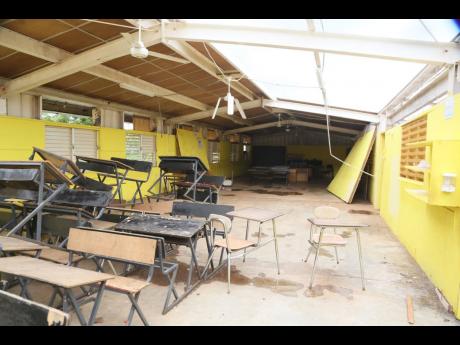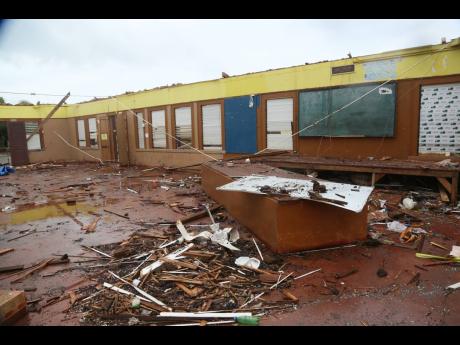Patricia Green | No quick fix in post-Beryl schools’ repair
The Royal Institute of British Architects 2024 publication 100 Women, Architects in Practice, was launched in February in London, United Kingdom. It features women architects globally from Africa, the Americas, Asia, Europe, and Oceania regions, including Nigerian architect Tosin Oshinowo, who wrote, “… I have learnt to be creative in the confines of scarcity …”.
As another architect in this book, I mentioned that my work process is relational and cross-cutting, hinging on historic precedence with a people-centred, culturally relevant, pioneering approach. I presented two of my projects, the Bob Marley Museum I conceptualised for Rita Marley, and the University Bookshop at the University of the West Indies, Mona.
Architect Oshinowo presented her Ngarannam Village project (2022) in Borro State, Nigeria. The village replaced a settlement destroyed by Boko Haram, an Islamist militant organisation. Instigated by the Nigerian government and the United Nations Development Programme, this village rebuilding aimed to coax people back to the region and contained some key community spaces, including a primary school.
Back-to-school, therefore, takes many heightened forms precipitated by destruction of property through conflicts and religious wars, such as those in Nigeria, or natural disasters, including the passing of Hurricane Beryl in Jamaica. Currently, therefore, in Jamaica, we are hearing repeatedly in the media that contractors are to hasten completion of post-Beryl school-reconstruction activities. The Gleaner, on August 25, carried lead reporting on such efforts.
News is replete over staff loss from Jamaican teachers migrating. However, it becomes necessary to recognise that there is also mass migration of knowledgeable and skilled Jamaican contractors and construction workers. Therefore, what skill sets are being engaged to handle school-building works?
BEGS THE QUESTION
Careful examination of Hurricane Beryl damage to school properties begs the question: Who is giving professional and technical guidance to contractors? What are the levels of professional inputs on material selection? Are best-practice principles being used, especially on roof repairs?
I was happy to encounter a skilled and gifted carpenter-plumber-mason visiting my brother and invited him to fix a cupboard under my bathroom basin. Hugging his daughters, he proudly announced that he is now working in The Cayman Islands. These islands are erecting new buildings and undertaking, continuously, maintenance of their public buildings. He is overextended with work at triple salary in The Cayman Islands, enabling him to handle family back-to-school obligations with ease.
Technically, we have observed that some roofing has rafters spaced too wide apart, beam depth appears too shallow, untreated lumber being used, increasing termite ( ’chi-chi’) infestation. All these would contribute to eventual structural failure, exacerbated by hurricane forces. Mitigation extends beyond use of hurricane straps. Add issues of adequate wall plates, placement of hold-down bolts securing plates into ring beams, notching rafters on to the plate, where required.
Migrating teachers cite more than salaries. Physical condition of classrooms looms high, especially excessive heat. What exacerbates such heat? The roof needs to allow venting of the hot air that rises into its space. When trapped without outlets, this descends into classrooms.
Historic buildings on school properties that survived Beryl’s destruction may serve as models for effective resilient roofing applications. Are these techniques being adopted into reconstruction guidelines as hurricane-mitigation construction? Several persons have been sending me reports of new works on historic buildings, including on school compounds. Engineers and other building professionals are expressing concerns that time-tested construction principles are being replaced on these without due attention to details for effective structural integrity. Consequently, buildings appear to be now more vulnerable and less resilient.
It is important to note that individuals and professional bodies have made representation in vain, at various times, to assist in school-building processes, especially during and after disaster situations.
CONDUCTED A SURVEY
At the height of the COVID-19 pandemic disaster which resulted in school-building lockdown, in 2021, during my tenure at the University of Technology, Jamaica, I conducted a regional project to survey some buildings in deep rural St Thomas. I spent a full day observing, with distress, that primary and high school children continuously played traditional games under the village ‘big-tree.’ Noticing the watchful eyes of the woman constable from the elevated police station, I had a long chat with her, learning that they had no Internet service. None were participating in any online classes. All the public buildings were locked. The big tree in the square was their holding area, and I witnessed their parents calling them, one by one, upon their return from work. What happened when it rained, I wondered?
That experience generated my September 6, 2021, Gleaner article, ‘Retrofit schools to ensure inclusive education.’ This article spoke to applying COVID-19 protocols to repurpose or retrofit some school buildings for such children. I wrote, “… as an architect, and there are others sensitised, it comes automatically to conceptualise design strategies for existing school buildings to make them inclusive environments to accommodate both the vaccinated and unvaccinated ...”. I went further to suggest ideas to achieve this: add simple lean-to extensions; replicate Jamaica ‘Labour Day’ scenarios with communities and the business sector helping to mobilise financial and human resources; make it a national activity; share best practices from such model communities making these physical adjustments; avoid segregation with stigmatisation of our Jamaican children.
Simultaneously, I penned a letter to the permanent secretary of the Ministry of Education, Youth and Information, volunteering my services: “Inclusive classrooms and school environments.”
We exchanged correspondence and held virtual meetings with various sections of the ministry. I asked for two schools as the pilot, one in deep rural and another in an urban setting, holding the criteria of children marginalised without Internet and devices to access on-line classes. The ideas were applauded, discussions were useful and went as far as the ministry suggesting some schools and communities that could become pilots.
Yet, after repeated follow-up attempts and phone calls, pandemic restrictions were removed without any engagement by the ministry to utilise my offer to assist children through my volunteering professionally to help during this disaster.
How many other professionals have had similar experiences? Various persons have asked me, repeatedly, Is your expertise as a consultant preservation architect being inputted on this or that heritage building?
Back-to-school needs a management system of ongoing maintenance by competent and qualified persons, especially engaging professionals in the process. Members of the Incorporated Masterbuilders Association of Jamaica should be included. We must safeguard national property and lives. Activities must become sustainable and resilient by following time-tested technical know-how and sound best-practices. School buildings become shelters during disasters, hence effective mechanisms and long-term strategies are essential versus what is loosely termed in the industry, ‘quick-fix’ activities that often prove more costly in the long term.
Patricia Green, PhD, a registered architect and conservationist, is an independent scholar and advocate for the built and natural environment. Send feedback to patgreen2008@gmail.com and columns@gleanerjm.com


